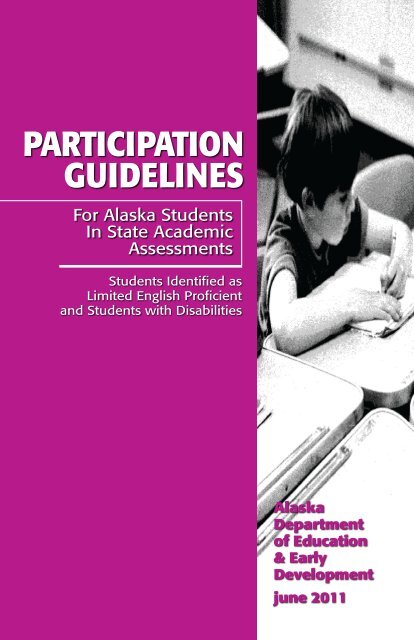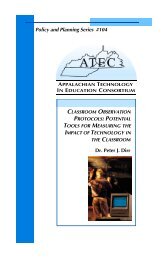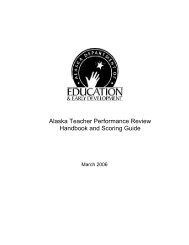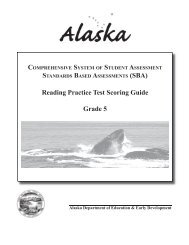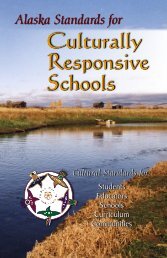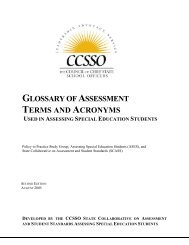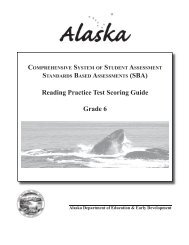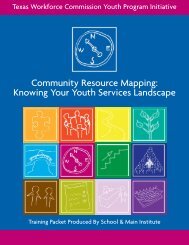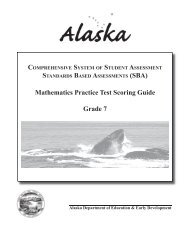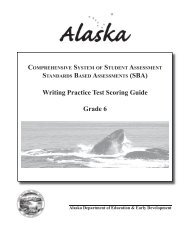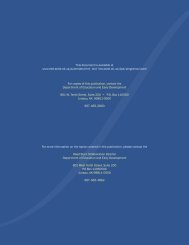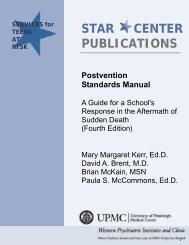Participation Guidelines for Alaska Students in State Assessments ...
Participation Guidelines for Alaska Students in State Assessments ...
Participation Guidelines for Alaska Students in State Assessments ...
Create successful ePaper yourself
Turn your PDF publications into a flip-book with our unique Google optimized e-Paper software.
PARTICIPATION<br />
GUIDELINES<br />
For <strong>Alaska</strong> <strong>Students</strong><br />
In <strong>State</strong> Academic<br />
<strong>Assessments</strong><br />
<strong>Students</strong> Identified as<br />
Limited English Proficient<br />
and <strong>Students</strong> with Disabilities<br />
<strong>Alaska</strong><br />
Department<br />
of Education<br />
& Early<br />
Development<br />
june 2011
TABLE OF CONTENTS<br />
Overview................................................................................................. 3<br />
STUDENTS WITH Limited English Proficiency.................................... 5<br />
Mak<strong>in</strong>g Decisions about <strong>Students</strong> who are Limited English Proficient ....... 5<br />
Who makes the decision on LEP accommodations?.................................. 5<br />
What are ELL–responsive accommodations? ............................................ 5<br />
Table 1. Accommodations Permissible <strong>for</strong> LEP <strong>Students</strong>............................ 7<br />
MAKING DECISIONS about <strong>Students</strong> with Disabilities...................... 9<br />
Diploma Track <strong>Students</strong>........................................................................... 9<br />
Categories of <strong>Students</strong> Who May be Eligible <strong>for</strong> Accommodations<br />
on <strong>State</strong>wide <strong>Assessments</strong>...................................................................... 9<br />
Test Accommodations and Modifications.................................................. 9<br />
Select<strong>in</strong>g Accommodations <strong>for</strong> <strong>Students</strong> .................................................. 10<br />
Table 2. Examples of Acceptable Accommodations................................... 11<br />
What should a team do when consider<strong>in</strong>g an adaptation<br />
on a regular assessment?....................................................................... 14<br />
Non-b<strong>in</strong>d<strong>in</strong>g Advisory Op<strong>in</strong>ion................................................................. 16<br />
ALTERNATIVE ASSESSMENT PROGRAM<br />
<strong>for</strong> High School Graduation .................................................................. 17<br />
The Modified HSGQE.............................................................................. 18<br />
When is a modification allowed on the modified HSGQE?........................ 18<br />
Table 3. Examples of Acceptable Modifications <strong>for</strong> the Modified HSGQE... 19<br />
Steps <strong>for</strong> us<strong>in</strong>g the modified HSGQE........................................................ 19<br />
What to do if you disagree with a rejection of requested modification........ 20<br />
The Nonstandardized HSGQE.................................................................. 20<br />
The Nonstandardized HSGQE Process...................................................... 22<br />
ALASKA ALTERNATE ASSESSMENT<br />
(AA-AAS) <strong>for</strong> Non-Diploma Track <strong>Students</strong>......................................... 25<br />
Criteria <strong>for</strong> IEP teams <strong>in</strong> determ<strong>in</strong><strong>in</strong>g student eligibility <strong>for</strong><br />
Alternate Assessment............................................................................. 26<br />
Alternate Assessment <strong>Participation</strong> Criteria Checklist................................ 26<br />
Accommodations and Assistive Devices/Supports..................................... 28<br />
WorkKeys <strong>Assessments</strong> <strong>for</strong> <strong>Students</strong> with Significant<br />
Cognitive Disabilities............................................................................. 28<br />
Glossary of Terms and Phrases............................................................. 29<br />
Appendix ................................................................................................ 33
OVERVIEW<br />
The <strong>Participation</strong> <strong>Guidel<strong>in</strong>es</strong> <strong>for</strong> <strong>Alaska</strong> <strong>Students</strong> <strong>in</strong> <strong>State</strong> Academic<br />
<strong>Assessments</strong> is designed to help <strong>Alaska</strong> fulfill the commitment to <strong>in</strong>clude<br />
all students <strong>in</strong> state assessments. Assessment of a student with a disability or<br />
limited English language proficiency is complicated because a disability or<br />
language can mask a student’s proficiency. Overcom<strong>in</strong>g this mask<strong>in</strong>g effect<br />
is important when assess<strong>in</strong>g students on the Standards Based <strong>Assessments</strong><br />
(SBAs) <strong>in</strong> grades 3 –10, the TerraNova <strong>in</strong> grades 5 and 7, and the High<br />
School Graduation Qualify<strong>in</strong>g Exam<strong>in</strong>ation (HSGQE).<br />
Limited English <strong>Students</strong><br />
This booklet outl<strong>in</strong>es the responsibilities of districts <strong>for</strong> accommodat<strong>in</strong>g students<br />
with limited English. Assessment of students with limited English<br />
proficiency (LEP) is required regardless of a student’s number of months or<br />
years <strong>in</strong> the United <strong>State</strong>s. Contact the department <strong>for</strong> conditions that apply<br />
to first year immigrants. It is important that LEP students are provided<br />
accommodations to fairly access the curriculum as well as participate <strong>in</strong><br />
content assessments. For detailed <strong>in</strong>structions on the selection, adm<strong>in</strong>istration<br />
and evaluation of LEP accommodations refer to the Test<strong>in</strong>g Accommodations<br />
Manual <strong>for</strong> LEP <strong>Students</strong> at the department website: www.eed.<br />
alaska.gov/tls/assessment/elp.html.<br />
<strong>Students</strong> with Disabilities<br />
This booklet expla<strong>in</strong>s the assessment options available to a student with a<br />
disability and the decisions that must be made by the student’s Individualized<br />
Education Program (IEP) or section 504 team. The first decision is<br />
whether a student is on a diploma track or a non-diploma track.<br />
A student who is not on a diploma track is required to participate <strong>in</strong> the<br />
alternate assessment, which is based on alternate achievement standards.<br />
<strong>Students</strong> on a diploma track will participate <strong>in</strong> the regular assessments. Decisions<br />
must be made regard<strong>in</strong>g how best to accommodate students so that<br />
their disability does not mask proficiency dur<strong>in</strong>g an assessment. In addition,<br />
if a student with a disability does not pass the HSGQE as a sophomore <strong>in</strong><br />
high school, decisions must be made on how to provide the student with an<br />
alternative assessment program, which consists of the modified HSGQE or<br />
nonstandardized HSGQE.
For detailed <strong>in</strong>structions on the selection, adm<strong>in</strong>istration and evaluation of<br />
accommodations <strong>for</strong> students with disabilities refer to the Accommodations<br />
Manual: How to Select, Adm<strong>in</strong>ister, and Evaluate Use of Accommodations <strong>for</strong><br />
Instruction and Assessment of <strong>Students</strong> with Disabilities at the department<br />
website: www.eed.alaska.gov/tls/assessment/accommodations.html.
STUDENTS WITH<br />
Limited English Proficiency<br />
LEP STUDENTS<br />
Mak<strong>in</strong>g Decisions about <strong>Students</strong> who are Limited English Proficient<br />
All students identified as Limited English Proficient (LEP) must participate <strong>in</strong><br />
statewide academic assessments. An LEP student is an <strong>in</strong>dividual whose first<br />
language is not English, or an American Indian, <strong>Alaska</strong> Native, or native resident<br />
who comes from an environment where a language other than English has had a<br />
significant impact on the <strong>in</strong>dividual’s level of English language proficiency [4 AAC<br />
34.090(a)(2)]. For the purposes of this guide, the term English language learner<br />
(ELL) refers to currently identified LEP students, not <strong>for</strong>mer LEP students. See<br />
the Guidance <strong>for</strong> Limited English Proficient Student Identification and Assessment<br />
on the department website at: www.eed.alaska.gov/tls/assessment/elp.<br />
html. <strong>Students</strong> identified as LEP must be provided reasonable accommodations<br />
on state academic assessments, to the extent practicable. Accommodations are<br />
allowed <strong>for</strong> LEP students when test<strong>in</strong>g <strong>for</strong> academic content knowledge and<br />
skills, but not when test<strong>in</strong>g <strong>for</strong> English language proficiency.<br />
Who makes the decision on LEP accommodations?<br />
Teams of people (teachers, adm<strong>in</strong>istrators, etc.) who know the educational<br />
needs of the LEP student should make decisions concern<strong>in</strong>g appropriate LEP accommodations<br />
to be used dur<strong>in</strong>g statewide content assessments. Teams should<br />
<strong>in</strong>clude a teacher or adm<strong>in</strong>istrator, when available, who has specialized tra<strong>in</strong><strong>in</strong>g<br />
or experience with limited English speak<strong>in</strong>g students and <strong>in</strong>struction. Because of<br />
the close l<strong>in</strong>k between assessment and <strong>in</strong>struction, the accommodations provided<br />
<strong>for</strong> the assessment should reflect those provided <strong>in</strong> classroom <strong>in</strong>struction and<br />
assessment. Research shows LEP students ga<strong>in</strong> <strong>in</strong> language acquisition yearly;<br />
there<strong>for</strong>e, accommodations should be reviewed accord<strong>in</strong>gly to reflect growth.<br />
Once a decision is made, it is essential to document the accommodations <strong>in</strong> the<br />
LEP student's file.<br />
What are ELL-responsive accommodations?<br />
The research-based LEP accommodations <strong>in</strong> Table 1 are ELL-responsive, i.e.,<br />
have been shown to support ELLs l<strong>in</strong>guistically <strong>in</strong> order to more accurately assess<br />
their academic content knowledge. Careful selection of ELL-responsive accommodations<br />
allows <strong>for</strong> mean<strong>in</strong>gful participation <strong>in</strong> content assessments and
ensures <strong>in</strong><strong>for</strong>mation obta<strong>in</strong>ed from the assessment is an accurate reflection of<br />
what the assessment is meant to measure rather than a measure of the students’<br />
English proficiency level. The accommodations that are adm<strong>in</strong>istrative practices,<br />
while not specifically responsive to the l<strong>in</strong>guistic needs of ELLs, can be helpful<br />
<strong>in</strong> adm<strong>in</strong>ister<strong>in</strong>g the content assessments. For detailed <strong>in</strong>structions on the selection,<br />
adm<strong>in</strong>istration and evaluation of LEP accommodations refer to the Test<strong>in</strong>g<br />
Accommodations Manual <strong>for</strong> LEP <strong>Students</strong> at the department website: www.<br />
eed.alaska.gov/tls/assessment/elp.html.<br />
Caution:<br />
• This section only applies to currently identified LEP students not <strong>for</strong>mer<br />
LEP students.<br />
• No LEP accommodations are permitted on the English Language Proficiency<br />
Assessment.<br />
• Do not refer to Table 1 <strong>for</strong> the NAEP or WorkKeys content assessments.<br />
NAEP and WorkKeys have specific accommodations <strong>for</strong> students with limited<br />
English. For WorkKeys accommodations refer to the section on locally<br />
approved accommodations <strong>in</strong> the WorkKeys supervisor's manuals and the<br />
<strong>Alaska</strong> Supplement <strong>for</strong> WorkKeys Assessment.<br />
Table 1 lists the only allowable accommodations LEP students may use on statewide<br />
academic assessments: Standards Based <strong>Assessments</strong>, HSGQE, Alternate,<br />
and TerraNova.
TABLE 1. Accommodations Permissible <strong>for</strong> LEP <strong>Students</strong> <strong>for</strong> Content <strong>Assessments</strong><br />
Reference<br />
Materials<br />
Direct L<strong>in</strong>guistic Support Accommodations<br />
Provide a commercial word-to-word bil<strong>in</strong>gual dictionary. Dictionaries<br />
that <strong>in</strong>clude pictures or word def<strong>in</strong>itions are not allowed.<br />
Electronic devices are not acceptable.<br />
Content<br />
Area<br />
Allowable<br />
<strong>for</strong> all<br />
content areas<br />
Test<br />
Directions<br />
Test Items<br />
Tim<strong>in</strong>g<br />
In English or the native language:<br />
• provide written version of written/oral test directions<br />
• read aloud* and/or repeat written and/or oral test directions<br />
• read aloud* and/or repeat embedded test directions<br />
• clarify/expla<strong>in</strong> test directions<br />
Direct L<strong>in</strong>guistic Support Accommodations<br />
Read aloud and repeat if requested: writ<strong>in</strong>g, math, and/or science<br />
test item <strong>in</strong> English.*<br />
Provide test contractor audio version of HSGQE <strong>for</strong> writ<strong>in</strong>g and/<br />
or math test. Allow student to replay as needed.<br />
Provide the native language word <strong>for</strong> an unknown word <strong>in</strong> a test<br />
item, when requested by student.<br />
Allow the student to respond orally to constructed response<br />
items <strong>in</strong> English <strong>for</strong> read<strong>in</strong>g, math, and/or science test(s); scribe<br />
response verbatim <strong>in</strong> English. (Reference scribe procedures after<br />
Table 2) This accommodation requires thoughtful consideration<br />
and will only apply to select students.<br />
Indirect L<strong>in</strong>guistic Support Accommodations<br />
Provide extended time.<br />
Provide scheduled breaks as needed dur<strong>in</strong>g test<strong>in</strong>g.<br />
Flexible Schedule: Adm<strong>in</strong>ister the test over several days<br />
complet<strong>in</strong>g on or be<strong>for</strong>e the last day of the test w<strong>in</strong>dow. (See<br />
Appendix <strong>for</strong> security procedures. For grade 10 SBA-HSGQE and<br />
the Retest, districts must submit an application to the department<br />
no later than 20 days prior to the first day of planned test<strong>in</strong>g.<br />
These students MUST have an EED approved application prior to<br />
the first day of planned test<strong>in</strong>g.)*<br />
Allowable<br />
<strong>for</strong> all<br />
content areas<br />
Content<br />
Area<br />
Not allowable<br />
<strong>for</strong> Read<strong>in</strong>g<br />
test<br />
Not allowable<br />
<strong>for</strong> Writ<strong>in</strong>g<br />
test<br />
Content<br />
Area<br />
Allowable<br />
<strong>for</strong> all<br />
content<br />
areas<br />
Test Adm<strong>in</strong>istration Practices<br />
Content<br />
Area<br />
Adm<strong>in</strong>ister the test <strong>in</strong>dividually.<br />
Allowable<br />
<strong>for</strong> all<br />
Adm<strong>in</strong>ister the test to small groups <strong>in</strong> a separate location. content areas<br />
Refer to the glossary <strong>for</strong> def<strong>in</strong>itions of words <strong>in</strong> bold pr<strong>in</strong>t.<br />
*Refer to Appendix and the Test<strong>in</strong>g Accommodations Manual <strong>for</strong> LEP <strong>Students</strong> <strong>for</strong> guidance.
MAKING DECISIONS<br />
About <strong>Students</strong> with Disabilities<br />
STUDENTS WITH<br />
DISABILITIES<br />
Diploma Track <strong>Students</strong><br />
Most students with a disability will be on the diploma track and will be taught<br />
and assessed under the per<strong>for</strong>mance standards conta<strong>in</strong>ed <strong>in</strong> the <strong>Alaska</strong> Standards:<br />
Content and Per<strong>for</strong>mance Standards <strong>for</strong> <strong>Alaska</strong> <strong>Students</strong>. They will take<br />
the same statewide academic assessments taken by students without disabilities.<br />
If a disability <strong>in</strong>terferes with a student’s ability to demonstrate proficiency on an<br />
assessment, the student should be provided with an accommodation.<br />
Categories of <strong>Students</strong> Who May be Eligible <strong>for</strong><br />
Accommodations on <strong>State</strong>wide Academic <strong>Assessments</strong><br />
• <strong>Students</strong> experienc<strong>in</strong>g transitory impairments, as designated by the Americans<br />
with Disabilities Act Amendments Act of 2008 (effective January 1,<br />
2009), an impairment with an actual or expected duration of 6 months or<br />
less.<br />
• <strong>Students</strong> receiv<strong>in</strong>g special education services pursuant to an Individual Education<br />
Program.<br />
• <strong>Students</strong> receiv<strong>in</strong>g modification or accommodations of the general education<br />
curriculum or the regular education environment pursuant to Section<br />
504 or the Rehabilitation Act of 1973.<br />
Test Accommodations and Modifications<br />
<strong>Students</strong> with disabilities and transitory impairments may use appropriate accommodations<br />
when tak<strong>in</strong>g assessments. A test<strong>in</strong>g accommodation is a change<br />
made to ensure that <strong>in</strong><strong>for</strong>mation obta<strong>in</strong>ed from a test is an accurate reflection<br />
of what the test is <strong>in</strong>tended to measure rather than a measure of the student’s<br />
disability.<br />
Example: Betty knows the answers to the math items on the state standards-based<br />
assessment, but, because of her disability, she has trouble hold<strong>in</strong>g<br />
a pencil and fill<strong>in</strong>g <strong>in</strong> the ovals on the answer sheet or writ<strong>in</strong>g answers<br />
to open-ended questions. Unless Betty is given an accommodation, the assessment<br />
will measure her ability to hold a pencil <strong>in</strong>stead of her knowledge<br />
of math. By provid<strong>in</strong>g Betty with a scribe, the school is able to accommodate<br />
her disability and measure her proficiency <strong>in</strong> math.
Accommodations are designed to meet specific needs of specific <strong>in</strong>dividuals. Accommodations<br />
must not compromise the validity of the test.<br />
Changes to a test that alter what is measured by the test or the validity of the result<br />
are called test modifications. For example, reduc<strong>in</strong>g the number of questions<br />
on a multiple-choice test would alter what is measured, and lower<strong>in</strong>g the pass<strong>in</strong>g<br />
score would alter the validity of the result. Modified tests would produce <strong>in</strong>valid<br />
test scores <strong>for</strong> the regular assessments <strong>in</strong> the statewide assessment system, and<br />
would not be scored by the test contractor.<br />
Caution: Remember that the modified HSGQE is a special assessment <strong>for</strong><br />
students with disabilities that is available after a student has not demonstrated<br />
proficiency on the regular assessment—the HSGQE. As expla<strong>in</strong>ed <strong>in</strong><br />
the Alternative Assessment Section, some modifications are allowed on the<br />
modified HSGQE.<br />
Select<strong>in</strong>g Test Accommodations <strong>for</strong> Transitory <strong>Students</strong><br />
<strong>Students</strong> with a transitory impairment are not regarded as <strong>in</strong>dividuals with disabilities<br />
if the impairment is transitory and m<strong>in</strong>or (Americans with Disabilities<br />
Act (ADA) Amendments Act of 2008, Section 3 (3)(B)). A transitory impairment<br />
is an impairment with an actual or expected duration of six months or less. A<br />
transitory impairment does not constitute a disability <strong>for</strong> purposes of Section 504<br />
unless its severity is such that it results <strong>in</strong> a substantial limitation of one or more<br />
major life activities <strong>for</strong> an extended period of time. On a case-by-case basis where<br />
appropriate documentation exists, students who are identified with a transitory<br />
impairment may receive test<strong>in</strong>g accommodations from Table 2 (e.g., student<br />
breaks arm and needs a scribe). The need <strong>for</strong> accommodations must be made by<br />
a school committee and documented prior to test<strong>in</strong>g. Copies of this documentation<br />
must be kept at the school or district. Decisions are made on a case-by-case<br />
basis dependent on the needs of the student and the construct measured on the<br />
assessment. Note: <strong>Students</strong> with a transitory impairment are not eligible to participate<br />
<strong>in</strong> the Alternative Assessment Program.<br />
Select<strong>in</strong>g Test Accommodations <strong>for</strong> <strong>Students</strong> with Disabilities<br />
The IEP or 504 team should select appropriate accommodations based on the student’s<br />
needs, and must provide documentation and the rationale <strong>for</strong> the accommodations<br />
on the IEP or 504 plan. Because of the close l<strong>in</strong>k between assessment and <strong>in</strong>struction,<br />
the IEP or 504 plan must describe how the accommodations <strong>for</strong> assessment<br />
are <strong>in</strong>cluded <strong>in</strong> the student’s classroom <strong>in</strong>struction and assessment. For more support<br />
when select<strong>in</strong>g accommodations refer to Accommodations Manual: How to Select,<br />
Adm<strong>in</strong>ister, and Evaluate Use of Accommodations <strong>for</strong> Instruction and Assessment<br />
of <strong>Students</strong> with Disabilities located at the department website: www.eed.alaska.<br />
gov/tls/assessment/accommodations.html.<br />
10
These guidel<strong>in</strong>es will provide assistance <strong>in</strong> determ<strong>in</strong><strong>in</strong>g whether an adaptation is an<br />
accommodation or a modification. (If we don’t know whether a device or change to<br />
a test is an accommodation or a modification, we call it an “adaptation” until we can<br />
determ<strong>in</strong>e which it is.) For assistance <strong>in</strong> select<strong>in</strong>g among accommodations, IEP or 504<br />
teams should review: www.eed.alaska.gov/tls/assessment/accommodations.html.<br />
Research shows that an unfamiliar test accommodation given to a student with a<br />
disability can sometimes lower test per<strong>for</strong>mance results. Accord<strong>in</strong>gly, an IEP or 504<br />
team should be cautious about add<strong>in</strong>g an accommodation shortly be<strong>for</strong>e an assessment.<br />
In general, a good practice is to make sure an accommodation has been used <strong>in</strong><br />
the student’s regular or special education classes <strong>for</strong> at least three months or 90 days<br />
be<strong>for</strong>e test<strong>in</strong>g. This will ensure that the student has experience with the accommodation<br />
and that the accommodation is appropriate <strong>for</strong> the student.<br />
Table 2 lists accommodations students may use on some content assessments: Standards<br />
Based Assessment, HSGQE, Alternate, and TerraNova. The NAEP and Work-<br />
Keys have specific accommodations <strong>for</strong> students with disabilities; do not<br />
refer to Table 2 <strong>for</strong> the NAEP and WorkKeys. For WorkKeys accommodations,<br />
please refer to the section on locally approved accommodations <strong>in</strong> the WorkKeys<br />
supervisor’s manuals and the <strong>Alaska</strong> Supplement <strong>for</strong> WorkKeys Assessment.<br />
TABLE 2. Examples of Acceptable Accommodations<br />
(NOT Exhaustive List) (Must Be Documented)<br />
TIMING/SCHEDULING (see appendix <strong>for</strong> guidance)<br />
• Allow<strong>in</strong>g frequent breaks dur<strong>in</strong>g test<strong>in</strong>g.<br />
• Allow<strong>in</strong>g additional time.<br />
• Adm<strong>in</strong>ister<strong>in</strong>g at a time of the day most beneficial to the student.<br />
• Adm<strong>in</strong>ister<strong>in</strong>g the test over several days complet<strong>in</strong>g the test<strong>in</strong>g on or<br />
be<strong>for</strong>e the last day of the test w<strong>in</strong>dow. (See appendix <strong>for</strong> security procedures.<br />
Grade 10 SBA–HSGQE and HSGQE Retest students must submit<br />
an application no later than 20 days prior to the first day of planned test<strong>in</strong>g.<br />
These students MUST have an EED approved application prior<br />
to the first day of planned test<strong>in</strong>g.)<br />
SETTING<br />
• Adm<strong>in</strong>ister<strong>in</strong>g the test <strong>in</strong>dividually <strong>in</strong> a separate location.<br />
• Adm<strong>in</strong>ister<strong>in</strong>g the test to a small group <strong>in</strong> a separate location.<br />
• Provid<strong>in</strong>g special light<strong>in</strong>g.<br />
• Provid<strong>in</strong>g adaptive or special furniture.<br />
• Provid<strong>in</strong>g special acoustics.<br />
11
• Adm<strong>in</strong>ister<strong>in</strong>g the test <strong>in</strong> locations with m<strong>in</strong>imal distractions (e.g.,<br />
small group, study carrel, or <strong>in</strong>dividually).<br />
• Us<strong>in</strong>g a communication device such as auditory amplification to give<br />
directions.<br />
• Us<strong>in</strong>g a specific test proctor (e.g., exam<strong>in</strong>ee’s regular or special<br />
education teacher).<br />
• Preferential seat<strong>in</strong>g.<br />
• Support of physical position of student by <strong>in</strong>creas<strong>in</strong>g or decreas<strong>in</strong>g<br />
opportunity <strong>for</strong> movement.<br />
• Us<strong>in</strong>g a checklist to rem<strong>in</strong>d student of tasks to be completed.<br />
PRESENTATION (see appendix <strong>for</strong> guidance)<br />
• Us<strong>in</strong>g the Braille edition or large-type (20 font size) edition, which is<br />
provided by the state test contractor.<br />
Test Directions (directions that are read aloud to all students by test<br />
adm<strong>in</strong>istrators and/or clarification of test directions embedded with<strong>in</strong> the tests.)<br />
• Sign<strong>in</strong>g directions to the student.<br />
• Allow<strong>in</strong>g student to ask <strong>for</strong> clarifications on test directions.<br />
• Clarify<strong>in</strong>g directions by hav<strong>in</strong>g student restate them.<br />
• Read<strong>in</strong>g and re-read<strong>in</strong>g if requested, embedded directions.<br />
• Provid<strong>in</strong>g written version of oral directions.<br />
• Present<strong>in</strong>g directions through use of projection equipment.<br />
• Provid<strong>in</strong>g highlighted words <strong>in</strong> embedded directions (must<br />
communicate with state to ensure test is not marked <strong>in</strong> any manner to<br />
cause test to be unscorable — Caution: Highlights on answer sheet<br />
will make the test unscorable).<br />
• Writ<strong>in</strong>g helpful verbs from the directions on the board or a separate<br />
piece of paper.<br />
Test Items<br />
• Read<strong>in</strong>g or sign<strong>in</strong>g math, science, and/or writ<strong>in</strong>g items on the state<br />
required assessments to student (not allowable on the read<strong>in</strong>g test).<br />
. .Numbers (e.g., 1,342) must be read/signed as, “one comma three four<br />
two”.<br />
• Sign<strong>in</strong>g is allowed as long as the sign does not cue the correct response<br />
to a question (e.g., the sign <strong>for</strong> triangle is a triangle and should not<br />
be used if it is a possible answer. It is appropriate to spell the word<br />
triangle rather than sign it).<br />
• Us<strong>in</strong>g test contractor sign<strong>in</strong>g DVD version of HSGQE writ<strong>in</strong>g and<br />
mathematics tests.<br />
12
• Us<strong>in</strong>g test contractor audio version of Grade 10 SBA-HSGQE or<br />
HSGQE Retest writ<strong>in</strong>g and mathematics tests if available.<br />
• Read<strong>in</strong>g or sign<strong>in</strong>g multi-step math, science, or writ<strong>in</strong>g test items<br />
one step at a time.<br />
• Assist<strong>in</strong>g student <strong>in</strong> track<strong>in</strong>g or sequenc<strong>in</strong>g test items.<br />
• Provid<strong>in</strong>g detailed monitor<strong>in</strong>g to ensure student marks responses <strong>in</strong><br />
correct answer area.<br />
• Turn<strong>in</strong>g pages <strong>for</strong> student.<br />
• Mask<strong>in</strong>g portions of the test to direct attention to uncovered items.<br />
• Us<strong>in</strong>g color screens to direct attention to specific sections on a page.<br />
• Allow student to highlight words except <strong>in</strong> answer document area.<br />
Use of Assistive Devices/Supports<br />
• Us<strong>in</strong>g a calculator with m<strong>in</strong>imal functions: hav<strong>in</strong>g only addition,<br />
subtraction, division, multiplication, percentage, square root, and<br />
memory functions (not available <strong>for</strong> the optional computational<br />
math portion of the TerraNova).<br />
• Us<strong>in</strong>g visual magnification devices.<br />
• Us<strong>in</strong>g templates to reduce visible pr<strong>in</strong>t.<br />
• Us<strong>in</strong>g auditory amplification device, hear<strong>in</strong>g aid, or noise buffers.<br />
• Secur<strong>in</strong>g papers to work area with tapes/magnets.<br />
• Us<strong>in</strong>g a device to screen out extraneous sounds (does not <strong>in</strong>clude<br />
music devices).<br />
• Us<strong>in</strong>g adaptive equipment to deliver test (requires consultation with<br />
the department <strong>for</strong> security reasons).<br />
• Us<strong>in</strong>g masks or markers to ma<strong>in</strong>ta<strong>in</strong> place.<br />
• Us<strong>in</strong>g special pen or pencil such as felt-tip marker or <strong>in</strong>k pen. (Student<br />
responses must be transcribed accord<strong>in</strong>g to procedures detailed<br />
<strong>in</strong> the test adm<strong>in</strong>istration directions.)<br />
• Us<strong>in</strong>g an adaptive keyboard.<br />
• Us<strong>in</strong>g math manipulatives.<br />
RESPONSE<br />
Test Format<br />
• Us<strong>in</strong>g graph paper.<br />
• Allow<strong>in</strong>g students to mark responses <strong>in</strong> test booklet if test employs<br />
a separate answer sheet. (Student responses must be transcribed accord<strong>in</strong>g<br />
to procedures detailed <strong>in</strong> the test adm<strong>in</strong>istration directions.)<br />
• Provid<strong>in</strong>g student with additional room <strong>for</strong> writ<strong>in</strong>g response. (Student<br />
responses must be transcribed accord<strong>in</strong>g to procedures detailed<br />
<strong>in</strong> the test adm<strong>in</strong>istration directions.)<br />
13
• Us<strong>in</strong>g color visual overlays.<br />
• Us<strong>in</strong>g ruler or object to ma<strong>in</strong>ta<strong>in</strong> place <strong>in</strong> test.<br />
• Us<strong>in</strong>g shield to reduce glare.<br />
Use of Assistive Devices/Supports<br />
• Allow<strong>in</strong>g student to tape response <strong>for</strong> later verbatim transcription.<br />
• Us<strong>in</strong>g computer without spell or grammar checker.<br />
• Dictat<strong>in</strong>g to a scribe <strong>for</strong> all tests (suggested scribe procedures below).<br />
• Allow<strong>in</strong>g alternative responses such as oral, sign, typed, po<strong>in</strong>t<strong>in</strong>g.<br />
• Us<strong>in</strong>g a Brailler.<br />
• Us<strong>in</strong>g a specially designed #2 pencil.<br />
* Suggested scribe procedures:<br />
1. Have student orally say how he or she wants the sentence to read, complet<strong>in</strong>g<br />
the full sentence (scribe should be familiar to the student).<br />
2. After student has completed the sentence, paragraph, or passage (this depends<br />
on <strong>in</strong>dividual student ability and need to reta<strong>in</strong> thought process)<br />
have student spell key words (e.g. nouns, verbs, etc.) <strong>in</strong> the sentence.<br />
3. The scribe should record verbatim the words, punctuation, and spell<strong>in</strong>g<br />
provided by the student.<br />
4. After the student has spelled the words, the student may look at the writ<strong>in</strong>g<br />
and complete the punctuation. The student may make additional spell<strong>in</strong>g<br />
corrections while complet<strong>in</strong>g the punctuation process.<br />
5. Allow student to review and approve what scribe has written. If necessary,<br />
the student can request the scribe to read aloud the completed text be<strong>for</strong>e<br />
f<strong>in</strong>al approval.<br />
*Because the grade level expectations <strong>in</strong> math, science, and read<strong>in</strong>g do not require<br />
spell<strong>in</strong>g and punctuation, math, science, and read<strong>in</strong>g scribes do not need<br />
to follow steps 2–4 of the suggested scribe procedures above.<br />
What should an IEP or 504 team do when consider<strong>in</strong>g an<br />
adaptation on a regular assessment that is not on Table 2?<br />
Any list of accommodations will be <strong>in</strong>complete because of the unique needs of<br />
each <strong>in</strong>dividual child. In addition, advances <strong>in</strong> the technology of adaptive and<br />
assistive devices will lead to new accommodations. Accord<strong>in</strong>gly, the accommodations<br />
listed <strong>in</strong> Table 2 are examples of acceptable accommodations, but an<br />
IEP team may need to consider the appropriateness of an accommodation not<br />
<strong>in</strong>cluded <strong>in</strong> Table 2.<br />
14
When evaluat<strong>in</strong>g an adaptation that is not <strong>in</strong>cluded <strong>in</strong> Table 2, an IEP team<br />
should answer the follow<strong>in</strong>g questions. First, the two threshold questions:<br />
1. Would the adaptation help the student demonstrate proficiency by reduc<strong>in</strong>g<br />
the effect of the disability on the student’s per<strong>for</strong>mance?<br />
2. Would the student use the adaptation <strong>in</strong> the classroom, <strong>in</strong>clud<strong>in</strong>g dur<strong>in</strong>g<br />
regular classroom assessments?<br />
If the answer to either 1 or 2 is no, then the adaptation is probably not a reasonable<br />
or appropriate accommodation <strong>for</strong> the assessment. If the answer to both is<br />
yes, then the next step is to determ<strong>in</strong>e whether the adaptation is an accommodation<br />
or a modification. To help make this dist<strong>in</strong>ction, the IEP or 504 team should<br />
answer the follow<strong>in</strong>g questions:<br />
3. Does the adaptation impede the measur<strong>in</strong>g of the skill that is be<strong>in</strong>g tested?<br />
This question is often difficult to answer, and the follow<strong>in</strong>g questions might<br />
help:<br />
a. Would the adaptation give the student an unfair advantage over a student<br />
who has the same proficiency level, and who is not eligible to use<br />
the adaptation?<br />
b. Does any research support the conclusion that this adaptation does not<br />
alter the ability of the test to measure the student’s skill level? (IEP or<br />
504 teams may consult with the department at any time.)<br />
Next, the team should consider questions that relate to whether the test could<br />
still be adm<strong>in</strong>istered:<br />
4. Would use of the adaptation cause a breach of test security? Be<strong>for</strong>e reject<strong>in</strong>g<br />
an adaptation <strong>for</strong> security reasons, an IEP or 504 team member or other<br />
school or district official should consult with the department. In special<br />
cases, security can be bolstered to accommodate special needs.<br />
5. Would use of the adaptation make it impossible to score the test? Be<strong>for</strong>e<br />
reject<strong>in</strong>g an adaptation because it changes or alters the test answer sheet, an<br />
IEP or 504 team member or other school or district official should consult<br />
with the department. In many cases, the adaptation may still be allowed if a<br />
test proctor can transfer the student’s answers to another answer sheet after<br />
the student completes the test.<br />
If the answer to questions 3, 4, or 5, is yes, then the adaptation is a modification,<br />
and is not allowed on regular assessments. IEP and Section 504 teams may still<br />
give students modifications, but the exams will be <strong>in</strong>validated and not scored. If<br />
the exam<strong>in</strong>ation is the HSGQE, the student will not be eligible <strong>for</strong> a high school<br />
diploma.<br />
If the answers to questions 3, 4, and 5 are no, then the adaptation is an allowable<br />
accommodation, and it may be used on regular academic assessments. This is<br />
particularly true if research supports the use of the accommodation.<br />
15
Example: John has an IEP <strong>for</strong> a learn<strong>in</strong>g disability and would like to take<br />
his standards based assessments at home where he feels more relaxed. He<br />
does not take his regular classroom tests at home, but is provided extra time<br />
and a smaller sett<strong>in</strong>g. His request is denied, because he does not use this<br />
accommodation <strong>in</strong> regular classroom work.<br />
Example: Anne has an IEP that directs she receive all of her <strong>in</strong>struction,<br />
<strong>in</strong>clud<strong>in</strong>g tests, at home. Anne requests to be able to take the HSGQE at<br />
home. After consult<strong>in</strong>g with the department, the district can protect test<br />
security by offer<strong>in</strong>g proctors <strong>for</strong> Anne’s assessment to be adm<strong>in</strong>istered <strong>in</strong> her<br />
home. This accommodation is allowed.<br />
Once test accommodations have been selected and documented <strong>in</strong> the IEP or<br />
504 Plan, the person responsible <strong>for</strong> adm<strong>in</strong>ister<strong>in</strong>g the test must be <strong>in</strong><strong>for</strong>med so<br />
that he/she is aware of the need to provide the accommodation. Additionally,<br />
some accommodations may require the assistance of support personnel or assistive<br />
devices, and plans should be made to ensure the necessary equipment and<br />
personnel are available at the time of test<strong>in</strong>g.<br />
Non-b<strong>in</strong>d<strong>in</strong>g Advisory Op<strong>in</strong>ion<br />
IEP or 504 teams, schools, and districts may consult with the department at any<br />
time when consider<strong>in</strong>g new adaptations, particularly when the adaptation is<br />
requested by a parent. In general, most IEP or 504 teams will be able to resolve<br />
issues regard<strong>in</strong>g the availability of adaptations. Sometimes, however, a district<br />
might determ<strong>in</strong>e that the adaptation is a modification while the parent th<strong>in</strong>ks it<br />
is an accommodation. If that happens, the parent may request that the district<br />
consult with the department first be<strong>for</strong>e reach<strong>in</strong>g its decision. The department<br />
will issue a non-b<strong>in</strong>d<strong>in</strong>g advisory op<strong>in</strong>ion on whether the requested change is an<br />
accommodation or a modification.<br />
If a parent requests an adaptation that is decl<strong>in</strong>ed by the IEP or 504 team, the<br />
district should advise the parent of parental appeal/due process rights, <strong>in</strong>clud<strong>in</strong>g<br />
the right to an adm<strong>in</strong>istrative compla<strong>in</strong>t or mediation. If possible, the district<br />
should provide notice to the parent <strong>in</strong> a timely manner, enabl<strong>in</strong>g the parent to<br />
appeal the decision be<strong>for</strong>e the test.<br />
If an IEP or 504 team requests a modification <strong>for</strong> an assessment, the district<br />
should allow the student to take the assessment with the modification if possible.<br />
The district should <strong>in</strong><strong>for</strong>m the IEP or 504 team that the modification will<br />
make the assessment results <strong>in</strong>valid and that the test will not be scored.<br />
Caution: Remember that the modified HSGQE is different from regular assessments.<br />
Some modifications may be allowed when a student is eligible <strong>for</strong> the<br />
alternative assessment program, which is described <strong>in</strong> the next section.<br />
16
ALTERNATIVE ASSESSMENT PROGRAM<br />
For High School Graduation<br />
Diploma track students will participate <strong>in</strong> the regular HSGQE that is first offered<br />
<strong>in</strong> the spr<strong>in</strong>g of a student’s sophomore year. As described <strong>in</strong> the previous section,<br />
a student with a disability should be offered appropriate accommodations when<br />
tak<strong>in</strong>g the HSGQE.<br />
If a student with a disability is not proficient on one or more subtests of the HS-<br />
GQE, the student is eligible <strong>for</strong> an alternative assessment program <strong>in</strong> the subtest(s)<br />
<strong>in</strong> which proficiency was not achieved. This is a special program <strong>for</strong> the HSGQE<br />
because it is a high-stakes exam<strong>in</strong>ation required <strong>for</strong> a high school diploma.<br />
The alternative assessment program consists of two different assessments: The<br />
modified HSGQE, which is appropriate <strong>for</strong> most students with disabilities, and<br />
the nonstandardized HSGQE, which is available <strong>for</strong> only a very few students. The<br />
modified HSGQE is offered <strong>in</strong> the spr<strong>in</strong>g and fall to all students with disabilities<br />
who have taken and not passed the HSGQE. The nonstandardized HSGQE is<br />
limited to students with severe physical or emotional disabilities who have taken<br />
the HSGQE, and who can document that they are unable to demonstrate their<br />
proficiency on a standardized assessment.<br />
Districts must apply to the department <strong>for</strong> approval of an alternative assessment.<br />
Furthermore, by February 1, of the student's junior year, or upon enrollment <strong>in</strong><br />
the state if the student enrolls after February 1, of student's junior year, the IEP/<br />
504 team must declare and document <strong>in</strong> the IEP/504 the alternative program<br />
of choice.<br />
Caution: Most students with disabilities are not eligible <strong>for</strong> the nonstandardized<br />
HSGQE and should cont<strong>in</strong>ue to take the modified HSGQE even if they have difficulty<br />
pass<strong>in</strong>g it. Moreover, because the nonstandardized HSGQE is a very rigorous<br />
assessment, some students who are eligible <strong>for</strong> this assessment may f<strong>in</strong>d that<br />
the modified HSGQE is more advantageous to them.<br />
If an eligible student receives a proficient score on either the modified HSGQE<br />
or the nonstandardized HSGQE, the student has satisfied state requirements <strong>for</strong><br />
pass<strong>in</strong>g the HSGQE. An eligible disabled student may meet state requirements <strong>for</strong><br />
pass<strong>in</strong>g the HSGQE us<strong>in</strong>g any comb<strong>in</strong>ation of test<strong>in</strong>g under standard conditions,<br />
test<strong>in</strong>g with the use of accommodations, or pass<strong>in</strong>g an approved alternative assessment<br />
(modified HSGQE or nonstandardized HSGQE).<br />
17
If a student does not achieve a proficient score on the HSGQE or the alternative<br />
assessment program, the student is eligible to receive a certificate of achievement<br />
if all other state and local requirements <strong>for</strong> graduation have been met.<br />
The Modified HSGQE<br />
The modified HSGQE is the HSGQE given with allowable modifications—changes<br />
to the test situation that normally would not be allowed. Some modifications<br />
are permitted because of the high stakes of the HSGQE and because the significant<br />
help they provide to a student outweighs their compromis<strong>in</strong>g effect on the<br />
validity of the test.<br />
The department and the IEP or 504 team have an important role to play <strong>in</strong><br />
decid<strong>in</strong>g whether a modification should be provided to a student. The IEP or<br />
504 team will determ<strong>in</strong>e whether a particular modification is appropriate <strong>for</strong> a<br />
student on the subtests of the HSGQE on which the student has had difficulty.<br />
The IEP or 504 team will then apply to the department <strong>for</strong> approval of the proposed<br />
modification. Forms are available onl<strong>in</strong>e: www.eed.alaska.gov/tls/assessment/modified.html.<br />
The department will determ<strong>in</strong>e whether the benefit of the<br />
modification outweighs its potentially adverse effect on the validity of the test.<br />
When is a modification allowed on the modified HSGQE?<br />
No def<strong>in</strong>itive list of allowable modifications can be made because of the variety<br />
of disabilities and educational programs provided to students with disabilities.<br />
Some changes to the HSGQE and its test adm<strong>in</strong>istration procedures cannot be<br />
allowed because the changes would make the test score mean<strong>in</strong>gless or compromise<br />
the security of the test. Although the follow<strong>in</strong>g list of disallowed modifications<br />
is not exhaustive, it should give guidance to IEP and 504 teams. Examples<br />
of disallowed modifications <strong>in</strong>clude:<br />
• Chang<strong>in</strong>g the cut score on the test.<br />
• Reduc<strong>in</strong>g the number of items on the test.<br />
• Help<strong>in</strong>g a student f<strong>in</strong>d the correct answer to a question.<br />
These modifications would prevent the state from measur<strong>in</strong>g a student’s<br />
proficiency.<br />
Examples of modifications that the department may approve are listed <strong>in</strong> Table<br />
3. An IEP or 504 team must apply <strong>for</strong> and receive approval <strong>for</strong> any modifications<br />
used on the modified HSGQE, even if the modification is listed <strong>in</strong> Table 3. Table<br />
3 is not comprehensive, however, and the department may approve other modifications<br />
<strong>for</strong> the modified HSGQE. Applications <strong>for</strong> the modified HSGQE will be<br />
considered on a case-by-case basis.<br />
18
TABLE 3. Examples of Acceptable Modifications <strong>for</strong> the Modified HSGQE<br />
• Allow<strong>in</strong>g a student to ask a test proctor <strong>for</strong> clarification of a test item.<br />
• Allow<strong>in</strong>g signer to clarify test items <strong>for</strong> a deaf student at student request.<br />
• Allow<strong>in</strong>g use of a spell check on a word processor.<br />
• Allow<strong>in</strong>g the read<strong>in</strong>g test to be read aloud (proctor/CD <strong>for</strong> audio and<br />
signer/DVD <strong>for</strong> hear<strong>in</strong>g impaired).<br />
• Allow<strong>in</strong>g use of a grammar check on a word processor.<br />
• Allow<strong>in</strong>g use of a graph<strong>in</strong>g/scientific calculator.<br />
• Allow<strong>in</strong>g a student the use of a dictionary and/or thesaurus.<br />
• Allow<strong>in</strong>g a student to use math or writ<strong>in</strong>g commercially published resource<br />
guides.<br />
• Allow<strong>in</strong>g voice recognition software and word processor.<br />
• Allow<strong>in</strong>g proctors to provide synonyms <strong>for</strong> unknown words if requested<br />
by student.<br />
Caution: These modifications may be used only <strong>in</strong> the modified HSGQE. Use<br />
of these modifications <strong>in</strong> a regular assessment would render the assessment<br />
<strong>in</strong>valid.<br />
Steps <strong>for</strong> us<strong>in</strong>g the modified HSGQE<br />
Convene a meet<strong>in</strong>g of the IEP or 504 team to discuss and determ<strong>in</strong>e the need<br />
<strong>for</strong> the modified HSGQE. Make sure that the IEP or 504 plan specifically lists<br />
the need <strong>for</strong> the modification(s) proposed <strong>for</strong> the modified HSGQE with<strong>in</strong> the<br />
program and assessment modification sections.<br />
Complete the Application <strong>for</strong> Modified HSGQE <strong>for</strong>m and mail or fax to the<br />
department. For purposes of privacy and security, electronic email submissions<br />
are not accepted. Be sure to <strong>in</strong>clude copies of the pages <strong>in</strong> the IEP or 504 plan<br />
that call <strong>for</strong> a modified HSGQE, and make sure that it identifies the student.<br />
Forms are available onl<strong>in</strong>e: www.eed.alaska.gov/tls/assessment/modified.<br />
html, and may also be obta<strong>in</strong>ed directly from the department. Modified HSGQE<br />
applications must be received 60 days be<strong>for</strong>e the date of test adm<strong>in</strong>istration to<br />
ensure that the request will be processed. If an application is received late, the<br />
department may not be able to process it be<strong>for</strong>e the test adm<strong>in</strong>istration and no<br />
reconsideration will be allowed on a decision made on a late-filed application.<br />
If the student’s application is accepted or partially accepted, it is the district's<br />
responsibility to ensure that the modifications are available on exam<strong>in</strong>ation day<br />
and the test proctor understands the test<strong>in</strong>g procedures.<br />
If an application is rejected, the IEP or 504 team may submit a new application<br />
with appropriate revisions and documentation.<br />
19
The department will approve a modified HSGQE only if it meets the follow<strong>in</strong>g<br />
requirements:<br />
1. The student has made at least one attempt to pass all sections of the HSGQE<br />
with or without accommodations.<br />
2. The student’s IEP or 504 team has designed the modification to fit the student’s<br />
needs and disability. This is further documented <strong>in</strong> the IEP or 504<br />
plan.<br />
• Appropriate: read<strong>in</strong>g disability request<strong>in</strong>g a read aloud modification.<br />
• Not appropriate: read<strong>in</strong>g disability request<strong>in</strong>g a calculator modification.<br />
3. The student uses the proposed modification on a regular basis <strong>in</strong> the classroom,<br />
or if not, an explanation of why not. This is evident when documented<br />
<strong>in</strong> the program modification section of the IEP/504 plan.<br />
4. The modification does not breach test security.<br />
5. The modification does not prevent the measurement, to the maximum extent<br />
possible, of the student’s proficiency on the standards tested on the<br />
HSGQE.<br />
6. The modification does not make it impossible <strong>for</strong> the test company to score<br />
the test.<br />
7. The application <strong>in</strong>cludes a copy of the relevant page(s) from the IEP or 504<br />
plan list<strong>in</strong>g and detail<strong>in</strong>g the modification(s) <strong>in</strong> the program and assessment<br />
sections of the IEP/504 plan.<br />
8. The requested modified HSGQE is <strong>for</strong> only those content areas <strong>in</strong> which the<br />
student received a score of less than proficient on the HSGQE.<br />
What to do if you disagree with a rejection of requested modification<br />
The department’s Alternative Assessment Program Manager makes the <strong>in</strong>itial<br />
decision regard<strong>in</strong>g modifications requested <strong>in</strong> an application <strong>for</strong> the modified HS-<br />
GQE. If a district disagrees with that decision, the district may request reconsideration<br />
of the decision by the commissioner, as provided <strong>in</strong> 4 AAC 06.775. Access<br />
the Modified/Nonstandardized HSGQE Request <strong>for</strong> Reconsideration <strong>for</strong>m<br />
(#05-05-019) at the department website: www.eed.alaska.gov/<strong>for</strong>ms/home.<br />
cfm.<br />
The Nonstandardized HSGQE<br />
The nonstandardized HSGQE requires a student to prepare an extensive collection<br />
of work that reflects competency <strong>in</strong> each of the state standards tested on<br />
the HSGQE. The work is then graded by a jury to ensure that the student has<br />
met those standards. The nonstandardized HSGQE is available only to disabled<br />
students who:<br />
20
• are work<strong>in</strong>g at or near grade level;<br />
• have taken but not passed the HSGQE with or without accommodations;<br />
and<br />
• have a documented history of be<strong>in</strong>g unable to demonstrate proficiency<br />
on a standardized assessment because of one or more of the follow<strong>in</strong>g<br />
conditions:<br />
• the student has a severe emotional or behavioral impairment or a pervasive<br />
developmental or other disability that causes the student to be<br />
unable to ma<strong>in</strong>ta<strong>in</strong> sufficient concentration to participate <strong>in</strong> standard<br />
test<strong>in</strong>g, even with accommodations or appropriate modifications;<br />
• the student cannot cope with the demands of a prolonged test adm<strong>in</strong>istration<br />
because of multiple physical disabilities, severe health related<br />
disabilities, or a neurological disorder;<br />
• the student has a significant motor or communication disability that<br />
causes the student to need more time than is reasonable or available <strong>for</strong><br />
test<strong>in</strong>g, even with the allowance of extended time.<br />
An IEP team must confirm that a student meets these requirements be<strong>for</strong>e allow<strong>in</strong>g<br />
a student to submit a nonstandardized HSGQE. The special education director<br />
or super<strong>in</strong>tendent must approve the student's eligibility <strong>for</strong> the nonstandardized<br />
HSGQE. Most disabled students, <strong>in</strong>clud<strong>in</strong>g those who have not yet passed<br />
the modified HSGQE, will take the modified HSGQE rather than participate <strong>in</strong><br />
the nonstandardized HSGQE.<br />
To have a student participate <strong>in</strong> the nonstandardized HSGQE, an IEP team<br />
should submit an application <strong>for</strong> the nonstandardized HSGQE on a <strong>for</strong>m provided<br />
by the department. All <strong>in</strong><strong>for</strong>mation and <strong>for</strong>ms are available at the department<br />
website: www.eed.alaska.gov/tls/assessment/nonstandardized.html, and<br />
may also be obta<strong>in</strong>ed directly from the department. The department suggests the<br />
application be submitted as soon as the IEP determ<strong>in</strong>es this option. The nonstandardized<br />
HSGQE regulation requires the application must be submitted on or<br />
be<strong>for</strong>e September 30, of the student's <strong>in</strong>tended year of graduation. Wait<strong>in</strong>g until<br />
the student’s senior year may limit other opportunities to pass the HSGQE. The<br />
application must <strong>in</strong>clude evidence to support the student’s eligibility, <strong>in</strong>clud<strong>in</strong>g:<br />
• diagnoses from a mental health cl<strong>in</strong>ician or the school psychologist;<br />
• evidence that the student is per<strong>for</strong>m<strong>in</strong>g at or near grade-level, <strong>in</strong>clud<strong>in</strong>g<br />
unmodified grades or per<strong>for</strong>mance on nonstandardized assessments;<br />
• evidence that the student cannot demonstrate the student’s proficiency on<br />
standardized assessments.<br />
The department’s Alternative Assessment Program Manager makes the <strong>in</strong>itial<br />
decision regard<strong>in</strong>g whether to accept an application <strong>for</strong> the nonstandardized HS-<br />
GQE. If a district disagrees with that decision, the district may request reconsid-<br />
21
eration of the decision by the commissioner, as provided <strong>in</strong> 4 AAC 06.775. Access<br />
the Modified/Nonstandardized HSGQE Request <strong>for</strong> Reconsideration <strong>for</strong>m (#05-<br />
05-019) at the department website: www.eed.alaska.gov/<strong>for</strong>ms/home.cfm.<br />
The Nonstandardized HSGQE Process<br />
The district must first convene a team to evaluate the nonstandardized HSGQE<br />
and certify that:<br />
• the work presented <strong>for</strong> evaluation was prepared exclusively by the student;<br />
• the extensive collection of work covers each of the standards described <strong>in</strong> the<br />
publication, The Nonstandardized Assessment Adm<strong>in</strong>istrative Manual; and<br />
• the extensive collection of work demonstrates proficiency on each of the<br />
standards described <strong>in</strong>, The Nonstandardized Assessment Adm<strong>in</strong>istrative<br />
Manual.<br />
The district team must <strong>in</strong>clude representatives from the IEP team and a content<br />
teacher <strong>for</strong> each content area addressed <strong>in</strong> the collection of work. If the district<br />
cannot verify that these conditions have been met, the district should not <strong>for</strong>ward<br />
the collection of work to the department <strong>for</strong> review by the state jury.<br />
The state nonstandardized HSGQE jury is a panel or panels of educators with<br />
expertise <strong>in</strong> the subject be<strong>in</strong>g tested. The jury will apply rigorous standards <strong>in</strong><br />
evaluat<strong>in</strong>g a collection of work to ensure that the work validly reflects proficiency<br />
<strong>in</strong> the state standards tested by the HSGQE. If, <strong>in</strong> evaluat<strong>in</strong>g the work, a jury<br />
cannot conclude that the work was prepared by the student or that the work<br />
demonstrates proficiency, the jury will reject the nonstandardized HSGQE. If the<br />
jury confirms that the student has demonstrated proficiency, the student will have<br />
successfully completed the alternative assessment program, and be eligible <strong>for</strong> a<br />
diploma.<br />
The scor<strong>in</strong>g of the nonstandardized HSGQE will be based on The Nonstandardized<br />
HSGQE Holistic Scor<strong>in</strong>g Guide. The scor<strong>in</strong>g guide requires significant quantities<br />
of evidence and consistency to ensure that the assessment is a valid and<br />
reliable <strong>in</strong>dicator of proficiency. The scor<strong>in</strong>g guide is located <strong>in</strong> the Nonstandardized<br />
Assessment Resource Guide. All <strong>for</strong>ms and scor<strong>in</strong>g guides are available at<br />
the department website: www.eed.alaska.gov/tls/assessment/nonstandardized.<br />
html.<br />
Special Cases<br />
In some rare and unusual circumstances, the situation might require that a student<br />
receive a waiver from the HSGQE requirement. For example, a student who<br />
has arrived late to the system or experienced a sudden and traumatic event close<br />
<strong>in</strong> time to the student’s f<strong>in</strong>al test may be eligible <strong>for</strong> a waiver. Districts, IEP and<br />
504 teams, and parents should carefully review the regulations govern<strong>in</strong>g waiv-<br />
22
ers: 4 AAC 06.772, 06.773, and 06.774, which can be accessed at the department<br />
website: www.eed.alaska.gov/organization.html.<br />
If a diploma track student is unable to participate <strong>in</strong> one or more subtests of<br />
the HSGQE, the student may be eligible to take the modified HSGQE <strong>for</strong> that<br />
subtest, or, if eligible, the nonstandardized HSGQE, <strong>in</strong> the student’s sophomore<br />
year. He or she may then obta<strong>in</strong> a waiver of the requirement to have first taken<br />
the HSGQE <strong>for</strong> that subtest. A student who is unable to participate should request<br />
permission from the district's govern<strong>in</strong>g body to take the modified or nonstandardized<br />
HSGQE <strong>in</strong> place of the HSGQE by October 31, of the student’s<br />
sophomore year, or <strong>in</strong> the first year that the student enrolls <strong>in</strong> public school <strong>in</strong><br />
the state. The request must <strong>in</strong>clude the follow<strong>in</strong>g:<br />
• a history of the student’s participation <strong>in</strong> assessments, <strong>in</strong>clud<strong>in</strong>g standardized<br />
assessments, <strong>for</strong> the subject area <strong>in</strong> which the student is unable to<br />
participate;<br />
• evidence from the historical record of the student’s IEPs that document and<br />
validate the student’s need <strong>for</strong> modification on standardized assessments;<br />
and<br />
• other evidence, which may <strong>in</strong>clude medical evidence, that documents the<br />
l<strong>in</strong>k between the disability and the modification.<br />
A govern<strong>in</strong>g body will grant this request only if the student has a history of not<br />
be<strong>in</strong>g able to participate <strong>in</strong> standardized assessments. If permission is granted,<br />
the application is state approved, the student passes all subtests and meets the<br />
other requirements of graduation, the IEP/504 team then applies <strong>for</strong> a waiver<br />
of the requirement to take the HSGQE <strong>in</strong> a standard <strong>for</strong>mat without modifications<br />
from the govern<strong>in</strong>g body. The department suggests the application <strong>for</strong> the<br />
nonstandardized HSGQE be submitted at the time of the Request <strong>for</strong> Permission<br />
is granted. Wait<strong>in</strong>g until the student’s senior year may limit other opportunities<br />
to pass the HSGQE.<br />
Example: Mark is bl<strong>in</strong>d and because of a physical disability cannot read<br />
Braille. He has excellent comprehension of written material, but must have<br />
all read<strong>in</strong>g assessments read aloud or presented on an audio version. He<br />
applies to take the modified HSGQE <strong>for</strong> read<strong>in</strong>g <strong>in</strong> place of the HSGQE <strong>in</strong><br />
his sophomore year, and his request is granted. He passes the modified read<strong>in</strong>g<br />
subtest, and passes the regular math and writ<strong>in</strong>g subtests. In his senior<br />
year he receives a waiver of the requirement that he take the HSGQE <strong>for</strong><br />
read<strong>in</strong>g.<br />
Caution: A request to take the modified or nonstandardized HSGQE <strong>in</strong> place<br />
of the HSGQE will not be granted unless a student is actually <strong>in</strong>capable of participat<strong>in</strong>g<br />
<strong>in</strong> the HSGQE. The <strong>in</strong>ability of a student to achieve a proficient score<br />
on a standardized assessment is not evidence that a student cannot participate<br />
<strong>in</strong> the HSGQE.<br />
23
ALASKA ALTERNATE ASSESSMENT<br />
Non-Diploma Track <strong>Students</strong><br />
<strong>Alaska</strong> Alternate Assessment<br />
based on Alternate Achievement Standards (AA-AAS)<br />
<strong>for</strong> Non-Diploma Track <strong>Students</strong><br />
<strong>Students</strong> with significant cognitive disabilities will have access to, participate<br />
<strong>in</strong>, and make progress <strong>in</strong> the general education curricula <strong>in</strong> compliance with<br />
the requirements of the federal Individuals with Disabilities Act (IDEA). All<br />
students must participate <strong>in</strong> statewide academic assessments <strong>in</strong> compliance<br />
with the Elementary and Secondary Education Act (ESEA). If students meet<br />
the criteria <strong>in</strong> the follow<strong>in</strong>g guidel<strong>in</strong>es, they will take an alternate assessment.<br />
It is expected that only a small number (less than two percent) of all students<br />
will participate <strong>in</strong> an alternate assessment.<br />
<strong>Students</strong> tak<strong>in</strong>g the <strong>Alaska</strong> Alternate Assessment are not eligible to receive a<br />
high school diploma but may be awarded a certificate of achievement if all<br />
other state and local graduation requirements are met. The <strong>Alaska</strong> Alternate<br />
Assessment assesses students with significant cognitive disabilities <strong>in</strong> grades<br />
3 through 10 <strong>in</strong> the content areas of read<strong>in</strong>g, writ<strong>in</strong>g, and mathematics. <strong>Students</strong><br />
<strong>in</strong> grades 4, 8, and 10 will also take the science alternate assessment.<br />
After grade 10, students are not assessed on the Standards Based Assessment<br />
or the Alternate Assessment.<br />
The <strong>Alaska</strong> Alternate Assessment is based on content standards called Extended<br />
Grade Level Expectations (ExGLEs) and alternate achievement standards<br />
(cut scores and descriptors) that are reduced <strong>in</strong> complexity and breadth and<br />
reflect a different set of academic expectations <strong>for</strong> students with significant<br />
cognitive disabilities. The ExGLEs and proficiency level descriptors are located<br />
at the department website: www.eed.alaska.gov/tls/Assessment/alternate.html.<br />
Only tra<strong>in</strong>ed and certified district personnel may adm<strong>in</strong>ister the <strong>Alaska</strong> Alternate<br />
Assessment. Districts must ensure they have an alternate assessment<br />
mentor prepared to tra<strong>in</strong> assessors. Contact the Alternate Assessment Program<br />
Manager <strong>for</strong> <strong>in</strong><strong>for</strong>mation on the mentor program.<br />
25
Criteria <strong>for</strong> IEP teams <strong>in</strong> determ<strong>in</strong><strong>in</strong>g student eligibility <strong>for</strong> Alternate<br />
Assessment<br />
Eligibility <strong>for</strong> the <strong>Alaska</strong> Alternate Assessment is a decision made by the Individualized<br />
Education Program (IEP) team members and reviewed on an annual basis.<br />
Decisions made by the IEP team are reflected on the student’s IEP and kept <strong>in</strong><br />
the student’s special education file.<br />
The IEP <strong>for</strong>m found <strong>in</strong> the Special Education Handbook <strong>in</strong>cludes a page <strong>for</strong><br />
select<strong>in</strong>g state and district-wide assessments. The section <strong>for</strong> students tak<strong>in</strong>g the<br />
Alternate Assessment must be completed and filed <strong>in</strong> the student’s special education<br />
file. This section <strong>in</strong>cludes the follow<strong>in</strong>g <strong>in</strong><strong>for</strong>mation:<br />
1. A statement that the <strong>Alaska</strong> Alternate Assessment is based on alternate achievement<br />
standards.<br />
2. Parents/guardians must be <strong>in</strong><strong>for</strong>med that the Alternate Assessment does not lead<br />
to a diploma. The parent/guardian is not giv<strong>in</strong>g permission to take the Alternate<br />
Assessment as that is an IEP team decision. A signature section is <strong>in</strong>cluded on<br />
the IEP to acknowledge that the parent/guardian has been notified the student<br />
is tak<strong>in</strong>g the Alternate Assessment <strong>for</strong> the current school year which is a nondiploma<br />
track assessment. If a parent/guardian does not attend the IEP meet<strong>in</strong>g,<br />
a letter of prior written notice must be sent <strong>in</strong><strong>for</strong>m<strong>in</strong>g the parent/guardian of<br />
the IEP team decision. If a parent/guardian withholds a signature, that does not<br />
override the decision of the IEP team regard<strong>in</strong>g Alternate Assessment participation.<br />
3. A statement <strong>in</strong> the IEP by the team describ<strong>in</strong>g why test<strong>in</strong>g on the Standards<br />
Based Assessment is not appropriate. The team must reference the student’s<br />
Evaluation Summary and Eligibility Report (ESER), the Present Levels of Academic<br />
Achievement and Functional Per<strong>for</strong>mance (PLAAFP), and/or the Alternate<br />
Assessment <strong>Participation</strong> Criteria Checklist to support the decision.<br />
4. A statement <strong>in</strong> the IEP by the team describ<strong>in</strong>g why the Alternate Assessment<br />
is appropriate based on the participation criteria. The team must reference the<br />
student’s Evaluation Summary and Eligibility Report (ESER), the Present Levels<br />
of Academic Achievement and Functional Per<strong>for</strong>mance (PLAAFP), and/or the<br />
Alternate Assessment <strong>Participation</strong> Criteria Checklist to support the decision.<br />
5. The <strong>Participation</strong> Criteria Checklist must be used <strong>for</strong> <strong>in</strong>itial eligibility and must<br />
be reviewed and <strong>in</strong>cluded <strong>in</strong> the IEP annually. The <strong>Participation</strong> Criteria Checklist<br />
is available on the department website: www.eed.alaska.gov/tls/Assessment/alternate.html.<br />
Alternate Assessment <strong>Participation</strong> Criteria Checklist<br />
The <strong>Participation</strong> Criteria Checklist must be a part of the decision mak<strong>in</strong>g process.<br />
If any response to the criteria is “No” or “Disagree”, the student must participate<br />
<strong>in</strong> regular state academic assessments with or without accommodations.<br />
26
Yes/ No/<br />
Agree Disagree<br />
Alternate Assessment <strong>Participation</strong><br />
Criteria Checklist (Include this checklist <strong>in</strong> the IEP)<br />
The student has an Individualized Education Program<br />
(IEP).<br />
The student meets the eligibility <strong>for</strong> special education<br />
related to the areas of, but not limited to, cognitive<br />
impairment, autism, traumatic bra<strong>in</strong> <strong>in</strong>jury, or multiple<br />
disabilities. However, the decision to participate <strong>in</strong> the<br />
Alternate Assessment is not based primarily on a specific<br />
eligibility determ<strong>in</strong>ation such as the student’s visual,<br />
auditory, physical, or emotional/behavioral disabilities.<br />
The student shows evidence of a significant cognitive<br />
disability and exhibits deficits <strong>in</strong> adaptive behavior/skills<br />
that adversely impacts the student’s educational per<strong>for</strong>mance<br />
and prevents completion of the standard academic<br />
curricula that leads to a diploma.<br />
The student requires extensive, frequent, <strong>in</strong>dividualized<br />
<strong>in</strong>struction <strong>in</strong> multiple sett<strong>in</strong>gs to acquire, ma<strong>in</strong>ta<strong>in</strong>,<br />
generalize, and demonstrate per<strong>for</strong>mance of skills.<br />
Objectives written <strong>for</strong> the student <strong>in</strong> the designated content<br />
area are less complex than the <strong>Alaska</strong> Grade Level<br />
Expectations, mak<strong>in</strong>g the regular assessment, even with<br />
adaptations (accommodations/modifications), <strong>in</strong>appropriate<br />
<strong>for</strong> this student.<br />
The adaptations (accommodations/modifications) needed<br />
by the student to participate <strong>in</strong> the regular assessment<br />
would compromise the validity of the test.<br />
The decision to participate <strong>in</strong> the Alternate Assessment<br />
is not based solely on excessive or extended absences.<br />
The decision to participate <strong>in</strong> the Alternate Assessment<br />
is not based solely on language, social, cultural, or economic<br />
differences.<br />
The decision to place the student on the Alternate<br />
Assessment is not be<strong>in</strong>g made <strong>for</strong> program adm<strong>in</strong>istration<br />
reasons, such as the student is expected to per<strong>for</strong>m<br />
poorly on the regular assessment; the student displays<br />
disruptive behaviors or experiences emotional distress<br />
dur<strong>in</strong>g test<strong>in</strong>g.<br />
27
Accommodations and Assistive Devices/Supports<br />
<strong>Students</strong> tak<strong>in</strong>g the Alternate Assessment may use appropriate accommodations<br />
<strong>in</strong>clud<strong>in</strong>g assistive devices/supports dur<strong>in</strong>g test<strong>in</strong>g. Accommodations and assistive<br />
devices/supports must be listed on the IEP and should be used frequently<br />
with the student <strong>in</strong> the classroom. This ensures the student is familiar with the<br />
accommodations, and that the appropriate accommodations/assistive devices/<br />
supports have been selected <strong>for</strong> the student.<br />
For additional guidance on test accommodations, see the section Table 2 –<br />
Examples of Acceptable Accommodations <strong>in</strong> this guidance document.<br />
WorkKeys <strong>Assessments</strong> <strong>for</strong> <strong>Students</strong> with Significant<br />
Cognitive Disabilities<br />
<strong>Students</strong> with significant cognitive disabilities <strong>in</strong> grade 11 or 12 may take the<br />
WorkKeys assessments <strong>in</strong> applied mathematics, read<strong>in</strong>g <strong>for</strong> <strong>in</strong><strong>for</strong>mation, and locat<strong>in</strong>g<br />
<strong>in</strong><strong>for</strong>mation if the IEP team determ<strong>in</strong>es it supports the transitional plan of<br />
the Individualized Education Program.<br />
28
GLOSSARY OF TERMS AND PHRASES<br />
Used <strong>in</strong> the <strong>Participation</strong> <strong>Guidel<strong>in</strong>es</strong><br />
504 Plan —A legal document fall<strong>in</strong>g under the provisions of the Rehabilitation<br />
Act of 1973. It is designed to plan a program of <strong>in</strong>structional services to assist<br />
students with special needs who are <strong>in</strong> a regular education sett<strong>in</strong>g. A 504 plan is<br />
not an Individualized Education Program (IEP) as is required <strong>for</strong> special education<br />
students. The full def<strong>in</strong>ition can be found at http://www2.ed.gov/about/offices/list/ocr/504faq.html.<br />
Adaptation —Any device or change provided to a student <strong>for</strong> test<strong>in</strong>g: "Adaptation"<br />
<strong>in</strong>cludes an accommodation or a modification.<br />
Accommodation — A change <strong>in</strong> <strong>for</strong>mat, response, sett<strong>in</strong>g, tim<strong>in</strong>g, or schedul<strong>in</strong>g<br />
that does not alter <strong>in</strong> any significant way what the test measures or the<br />
comparability of scores.<br />
Alternate Achievement Standards —Expectations of per<strong>for</strong>mance that differ<br />
<strong>in</strong> complexity from grade-level achievement standards.<br />
Alternate Assessment — An assessment used with significantly cognitively<br />
disabled students that measures the student's proficiency on the general curriculum<br />
aga<strong>in</strong>st alternate achievement standards. <strong>Students</strong> tak<strong>in</strong>g the Alternate<br />
Assessment are on the non-diploma track.<br />
Alternative Assessment Program —The modified HSGQE and the nonstandardized<br />
HSGQE.<br />
Certificate of Achievement — A certificate acknowledg<strong>in</strong>g that a student has<br />
met all district requirements <strong>for</strong> graduation, but has not passed the HSGQE.<br />
Clarify—To make clear. In reference to LEP test<strong>in</strong>g accommodations, this<br />
term may <strong>in</strong>clude expla<strong>in</strong><strong>in</strong>g and/or simplify<strong>in</strong>g test directions.<br />
Content Area —read<strong>in</strong>g, writ<strong>in</strong>g, math, and science subtests.<br />
EED — <strong>Alaska</strong> Department of Education & Early Development<br />
ELL—English language learner. For the purpose of this document and the use<br />
of accommodations <strong>for</strong> content test<strong>in</strong>g, the term ELL is def<strong>in</strong>ed as a currently<br />
identified LEP student who is not yet proficient on the ELP Assessment.<br />
ELL-Responsive Accommodation— An accommodation <strong>for</strong> ELLs that<br />
provides assistance <strong>in</strong> overcom<strong>in</strong>g l<strong>in</strong>guistic barriers to enable students to ac-<br />
29
cess the content of the assessment and demonstrates what they know and can<br />
do, based on documented research <strong>in</strong> The Best Practices <strong>in</strong> <strong>State</strong> Assessment<br />
Policies.<br />
ELP—English language proficiency<br />
Embedded Directions — Directions <strong>for</strong> the student that are written with<strong>in</strong><br />
the assessment and can be read aloud by the test adm<strong>in</strong>istrator or proctor as an<br />
accommodation.<br />
High Stakes Test — A test used to provide results that have important, direct<br />
consequences <strong>for</strong> exam<strong>in</strong>ees, programs, or <strong>in</strong>stitutions <strong>in</strong>volved <strong>in</strong> the test<strong>in</strong>g.<br />
The HSGQE is a high stakes test because students are required to pass the HSGQE<br />
<strong>in</strong> order to receive a diploma.<br />
HSGQE —High School Graduation Qualify<strong>in</strong>g Exam<strong>in</strong>ation<br />
IEP —Individualized Education Program<br />
LEP —Limited English proficient. Def<strong>in</strong>ed <strong>in</strong> state regulation 4 AAC 34.090(a)(2).<br />
L<strong>in</strong>guistic Support—Assistance <strong>in</strong> overcom<strong>in</strong>g language related barriers<br />
dur<strong>in</strong>g content test<strong>in</strong>g <strong>for</strong> LEP students.<br />
Modification —A change <strong>in</strong> the content, <strong>for</strong>mat, and/or adm<strong>in</strong>istration of a test<br />
that alters what the test is designed to measure or the comparability of scores.<br />
Generally, a modification makes an assessment <strong>in</strong>valid. The HSGQE may be taken<br />
with approved modifications because it is a special case.<br />
Modified HSGQE —The HSGQE given with modifications that have been approved<br />
by EED through an application process.<br />
Non-Diploma Track —An alternate academic approach that does not lead to<br />
a diploma.<br />
Nonstandardized HSGQE —An assessment <strong>for</strong> students with disabilities that<br />
requires a student to prepare an extensive collection of work. Proficiency on the<br />
nonstandardized HSGQE requires competency <strong>in</strong> every one of the state standards<br />
that are tested on the HSGQE.<br />
<strong>Participation</strong> <strong>Guidel<strong>in</strong>es</strong> (PG) — A booklet provid<strong>in</strong>g guidance to school district<br />
officials, adm<strong>in</strong>istrators, teachers, and other persons responsible <strong>for</strong> mak<strong>in</strong>g<br />
decisions about the participation <strong>in</strong> assessments of students on an Individualized<br />
Education Program (IEP), students on federal 504 Plans, students with transitory<br />
impairments, and students with limited English proficiency. It also provides guidance<br />
<strong>for</strong> decid<strong>in</strong>g if a student requires a test<strong>in</strong>g accommodation, modification,<br />
the modified HSGQE or the nonstandardized HSGQE.<br />
Proficiency — Achievement of the per<strong>for</strong>mance criteria required.<br />
30
Proctor — Refers to a person who adm<strong>in</strong>isters the HSGQE. Proctor qualifications<br />
are determ<strong>in</strong>ed through regulation 4 ACC 06.755(c). Proctors are required to<br />
adm<strong>in</strong>ister the HSGQE and must hold a state teacher certification issued under<br />
4 AAC 12.300.<br />
Resource Guides—A guide <strong>for</strong> math and writ<strong>in</strong>g provided by the state or<br />
approved by the state.<br />
SBA — Standards Based Assessment<br />
Test Adm<strong>in</strong>istrator—Includes anyone who adm<strong>in</strong>isters a statewide assessment,<br />
<strong>in</strong>clud<strong>in</strong>g proctors. The Standards Based <strong>Assessments</strong> do not require a<br />
proctor; there<strong>for</strong>e those adm<strong>in</strong>ister<strong>in</strong>g the exam<strong>in</strong>ations are referred to as test<br />
adm<strong>in</strong>istrators.<br />
Test Directions—Oral directions on the assessment that are read aloud to all<br />
students dur<strong>in</strong>g test<strong>in</strong>g by test adm<strong>in</strong>istrators and/or proctors. Test directions do<br />
not <strong>in</strong>clude test items. In terms of accommodations, test directions may <strong>in</strong>clude<br />
embedded directions.<br />
Test Item—The elements that create a measurable response: read<strong>in</strong>g passages,<br />
questions, embedded directions, and answer choices.<br />
Transitory Impairment — An impairment with an actual or expected duration<br />
of six months or less. A transitory impairment does not constitute a disability<br />
<strong>for</strong> purposes of Section 504 unless its severity is such that it results <strong>in</strong> a substantial<br />
limitation of one or more major life activities <strong>for</strong> an extended period of time.<br />
31
APPENDIX<br />
<strong>for</strong> the <strong>Participation</strong> <strong>Guidel<strong>in</strong>es</strong><br />
Flexible Schedule: Tables 1 and 2<br />
Adm<strong>in</strong>ister<strong>in</strong>g the test over several days complet<strong>in</strong>g by the last day of the test<br />
w<strong>in</strong>dow.<br />
<strong>Students</strong> who use the accommodation to test over several days do not have to<br />
complete the entire subtest <strong>in</strong> one day. Grade 10 SBA–HSGQE and HSGQE Retests<br />
must be completed on or be<strong>for</strong>e the last day of the three day test<strong>in</strong>g w<strong>in</strong>dow.<br />
Standards Based <strong>Assessments</strong> and TerraNova must be taken dur<strong>in</strong>g the designated<br />
test<strong>in</strong>g w<strong>in</strong>dow and completed prior to the last day of the test<strong>in</strong>g w<strong>in</strong>dow.<br />
Description<br />
This accommodation allows a subtest to be adm<strong>in</strong>istered over a period of days.<br />
As with all accommodations, the request to test over several days must be documented<br />
<strong>in</strong> the IEP/504 plan, transitory impairment, or LEP documentation 1 .<br />
Furthermore, this type of request should reflect like-type accommodations tak<strong>in</strong>g<br />
place <strong>in</strong> the classroom and must be documented <strong>in</strong> the Program Modifications<br />
and Supports section of the IEP. All documentation application materials (<strong>for</strong>ms<br />
05-05-029 and 05-05-30) necessary <strong>for</strong> the flexible schedul<strong>in</strong>g accommodation<br />
are available at the department website: www.eed.alaska.gov/<strong>for</strong>ms/home.cfm.<br />
Flexible Schedul<strong>in</strong>g Procedures<br />
The <strong>in</strong>tent of this accommodation is to support students who cannot complete a<br />
subtest with<strong>in</strong> one test<strong>in</strong>g day and are per<strong>for</strong>m<strong>in</strong>g at or near grade level.<br />
Specific to Grade 10 SBA–HSGQE and HSGQE Retests<br />
1. Deadl<strong>in</strong>e. An application <strong>for</strong> flexible schedul<strong>in</strong>g must be submitted to the<br />
department no less than 20 work<strong>in</strong>g days prior to test<strong>in</strong>g.<br />
2. Application. A Flexible Schedul<strong>in</strong>g Application <strong>for</strong>m MUST be completed<br />
<strong>for</strong> each test adm<strong>in</strong>istration and approved by EED <strong>for</strong> the Grade 10 SBA–HS-<br />
GQE and HSGQE Retest. Applications must <strong>in</strong>clude documentation (pages<br />
from the IEP that list assessment and program accommodations) and proof<br />
show<strong>in</strong>g the student cannot f<strong>in</strong>ish one subtest <strong>in</strong> one day 2 . Fax the com-<br />
1<br />
IEP/504 Plan, transitory impairment, or LEP documentation must explicitly <strong>in</strong>dicate the subtest<br />
should be adm<strong>in</strong>istered over several days.<br />
2<br />
Documentation may <strong>in</strong>clude <strong>in</strong>complete test results based on district test coord<strong>in</strong>ator’s data<br />
and/or time sheets <strong>in</strong>dicat<strong>in</strong>g student was unable to complete a subtest <strong>in</strong> one day dur<strong>in</strong>g prior<br />
test<strong>in</strong>g opportunities.<br />
33
pleted application, the Terms of Agreement, the IEP pages <strong>in</strong>dicat<strong>in</strong>g state/<br />
district assessment adaptations, and program modifications & supports to the<br />
department (907-465-8400) <strong>for</strong> approval no less than 20 work<strong>in</strong>g days<br />
prior to the first day of planned test<strong>in</strong>g. <strong>Students</strong> enroll<strong>in</strong>g <strong>in</strong> districts late<br />
will be considered on a case by case basis.<br />
a. Terms of Agreement The Flexible Schedul<strong>in</strong>g Terms of Agreement<br />
<strong>for</strong>m must be reviewed with the student and parents and signed by all<br />
parties prior to adm<strong>in</strong>istration of the Grade 10 SBA–HSGQE or HSGQE<br />
Retest. Fax this <strong>for</strong>m with the signatures from all <strong>in</strong>volved parties to<br />
the department (907-465-8400) no less than 20 work<strong>in</strong>g days<br />
prior to the first day of planned test<strong>in</strong>g. This <strong>for</strong>m MUST accompany the<br />
application.<br />
Specific to SBA and TerraNova<br />
1. Districts must create a management system when us<strong>in</strong>g flexible schedul<strong>in</strong>g<br />
with the SBA (3-9) and TerraNova to ensure all students us<strong>in</strong>g this accommodation<br />
are eligible (i.e., documentation exists verify<strong>in</strong>g that the student<br />
cannot complete a subtest <strong>in</strong> a s<strong>in</strong>gle day 1 ; IEP/504, transitory impairment,<br />
or LEP documentation reflects the need <strong>for</strong> this accommodation, and liketype<br />
accommodations are tak<strong>in</strong>g place <strong>in</strong> the classroom).<br />
2. As part of the management system, the Flexible Schedul<strong>in</strong>g Terms of Agreement<br />
<strong>for</strong>m must be reviewed with the student and parents and signed by<br />
all parties prior to adm<strong>in</strong>istration of the assessment. The <strong>for</strong>m with the signatures<br />
from all <strong>in</strong>volved parties must be kept on file and accessible to the<br />
district test coord<strong>in</strong>ator.<br />
Flexible Schedul<strong>in</strong>g Security Procedures <strong>for</strong> All <strong>Assessments</strong><br />
1. Test adm<strong>in</strong>istrators must document how security will be ma<strong>in</strong>ta<strong>in</strong>ed (i.e.,<br />
test<strong>in</strong>g location, test<strong>in</strong>g dates, pages to be completed, and storage procedures<br />
to ma<strong>in</strong>ta<strong>in</strong> security). Special arrangements may be needed to accommodate<br />
test<strong>in</strong>g over several days. The student will need a secure space <strong>for</strong><br />
test<strong>in</strong>g.<br />
2. <strong>Students</strong> may not revisit completed parts of a test or review future portions<br />
of a test. Use of paper clips or rubber bands is suggested to secure the pages<br />
completed or planned <strong>for</strong> future test<strong>in</strong>g sessions. Do not staple or tape<br />
any part of the test.<br />
1<br />
Documentation may <strong>in</strong>clude <strong>in</strong>complete test results based on district test coord<strong>in</strong>ator’s data<br />
and/or time sheets <strong>in</strong>dicat<strong>in</strong>g student was unable to complete a subtest <strong>in</strong> one day dur<strong>in</strong>g prior<br />
test<strong>in</strong>g opportunities.<br />
34
Read Aloud Test Directions and Items: Tables 1, 2 and 3<br />
Read<strong>in</strong>g the test directions or items aloud. (<strong>in</strong>dividual or small group)<br />
The read aloud accommodation may be used to read aloud any directions, writ<strong>in</strong>g<br />
prompts, test passages and questions, and/or answer choices on the mathematics,<br />
science and writ<strong>in</strong>g subtests <strong>in</strong>cluded <strong>in</strong> statewide academic assessments:<br />
Standards Based Assessment, HSGQE, Alternate, and TerraNova. This<br />
accommodation applies beyond the test<strong>in</strong>g directions that proctors and test adm<strong>in</strong>istrators<br />
are directed to read aloud <strong>in</strong> the test adm<strong>in</strong>istration manuals and<br />
<strong>in</strong>cludes embedded test directions.<br />
Caution: The read aloud <strong>for</strong> the read<strong>in</strong>g subtest is considered a modification<br />
and only available through the modified HSGQE application process. The read<br />
aloud modification allows the read<strong>in</strong>g of all test directions, read<strong>in</strong>g passages, test<br />
items, and/or answer choices on the read<strong>in</strong>g subtest <strong>for</strong> the modified HSGQE.<br />
Description<br />
This accommodation or modification permits directions embedded <strong>in</strong> the test as<br />
well as content to be read aloud to a student dur<strong>in</strong>g the test adm<strong>in</strong>istration. As<br />
with all accommodations and modifications, the use must be documented <strong>in</strong> the<br />
IEP/504 plan, transitory impairment, or LEP documentation. Furthermore, this<br />
type of accommodation or modification must reflect like-type classroom <strong>in</strong>struction.<br />
F<strong>in</strong>ally, the follow<strong>in</strong>g considerations and <strong>in</strong>structions do not consider other<br />
accommodations or modifications <strong>in</strong> conjunction to the read aloud. Consequently,<br />
proctors/test adm<strong>in</strong>istrators must assemble groups which reflect identical<br />
IEP/504, transitory impairment, or LEP programs <strong>for</strong> assessment purposes.<br />
Considerations and Instructions<br />
1. <strong>Students</strong> who use this accommodation or modification must be tested <strong>in</strong> a<br />
separate room to avoid disturb<strong>in</strong>g other students.<br />
2. For words located on a map, chart, table, etc., the proctor/test adm<strong>in</strong>istrator<br />
may either (a) read all words to the student at one time or (b) <strong>in</strong><strong>for</strong>m the<br />
student that the <strong>in</strong><strong>for</strong>mation can be read aloud upon student request.<br />
3. The proctor/test adm<strong>in</strong>istrator must avoid any restat<strong>in</strong>g or paraphras<strong>in</strong>g<br />
of embedded directions, test items, and the like (these guidel<strong>in</strong>es do not<br />
consider other accommodations or modifications <strong>in</strong> conjunction to the read<br />
aloud). Additionally, the proctor/test adm<strong>in</strong>istrator must not cue or prompt<br />
student responses.<br />
4. The proctor/test adm<strong>in</strong>istrator must avoid any exaggerated <strong>in</strong>flection, which<br />
could be <strong>in</strong>terpreted by the student as an encouragement or prompt.<br />
35
Publication Notice:<br />
This booklet was published by the Department of Education &<br />
Early Development. It was pr<strong>in</strong>ted at a cost of $.90 per copy <strong>in</strong><br />
Juneau. Publication date: June 2011
Department of Education & Early Development<br />
801 W. 10th Street, #200<br />
PO Box 110500, Juneau, AK 99811-0500<br />
Phone: (907) 465-2900<br />
www.eed.alaska.gov


